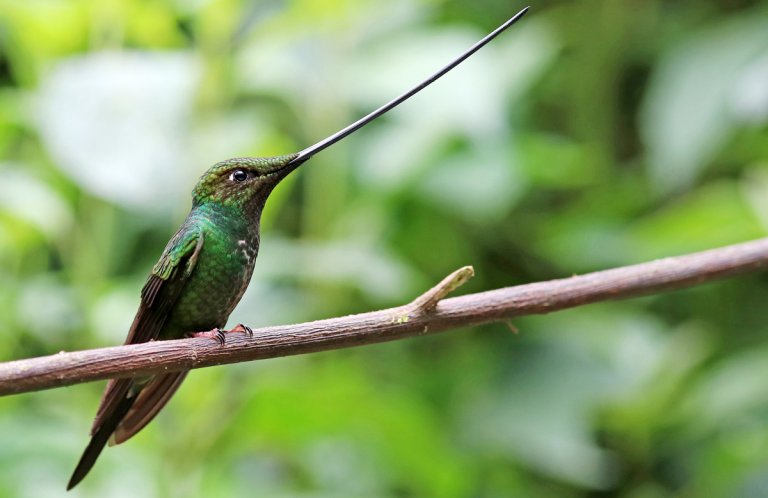About the Green-breasted Mango
A mango is more than a delicious fruit! It's also a group of neotropical hummingbird species, exemplified this week by the striking Green-breasted Mango. In this species, the male appears dark, but seen in good light, is deep green with black running down its throat, breast, and belly, bordered on either side by glittering lime and teal. Its dark reddish-purple tail is especially noticeable when spread and in flight.
Females and juvenile males are eye-catching in a different way: they have the same vertical black stripe on the underside as males, but it stands out more noticeably against their white underparts. In juveniles, the chest and throat are also bordered by two burnt orange stripes. The outer tail feathers of females and juveniles are banded in magenta and dark blue, with narrow white tips.
Fruit and Coal
The use of the word “mango” for a group of hummingbirds began by accident. Apparently, an Englishman studying bird specimens mixed up a hummingbird collected in Jamaica with that of a Eurasian Golden Oriole, commonly known as a Mango bird. Despite the mistake, the name “mango” has stuck to that New World family of hummingbirds ever since.
The Green-breasted Mango's genus name, Anthracothorax, combines the Ancient Greek words for “coal” and “chest,” referring to the black stripe that runs down the center of its throat and breast. Other mango species share this characteristic, as well as black, decurved bills.
Songs and Sounds
The call of the Green-breasted Mango is a high-pitched tsup, and its song is a buzzing, repeated kazick-kazee.
Listen here:
Breeding and Feeding
Like relatives ranging from the Sword-billed Hummingbird to the Short-crested Coquette, the Green-breasted Mango forms no pair bonds. Males court females that enter their territory by flying in a U-shaped pattern in front of them. After mating, the female is on her own to choose a nest location, build a nest, and raise her young. Both sexes may mate with multiple partners.

The female Green-breasted Mango builds a tiny, cup-shaped nest out of plant fibers lined with softer materials such as animal hair and feather down. She adds sticky, elastic spider web to the outside of her nest, which allows it to stretch as her chicks grow. Her clutch consists of two tiny eggs, which she incubates for several weeks. After the young hatch, she feeds them regurgitated insects, a vital source of protein needed for quick growth. The chicks fledge when they're close to a month old.
The Green-breasted Mango mainly feeds on flower nectar from trees, shrubs and epiphytes. It also takes small insects such as mosquitos, gnats, and fruit flies. Along with other “suburban” hummingbird species such as the Ruby-throated Hummingbird and Swallow-tailed Hummingbird, it readily visits backyard gardens and feeders to sip nectar and sugar water. This hummingbird often fans its colorful tail while feeding.
Region and Range

The range of the Green-breasted Mango stretches from the eastern coasts of central and southern Mexico into Central America, with a few locations in northern South America. A few vagrants occasionally reach the United States. Some populations are partly migratory; Green-breasted Mangos breeding in Oaxaca have been observed moving south for the winter season.
Four subspecies of Green-breasted Mango are recognized. A fifth was recently re-classified as a subspecies of the closely-related Black-throated Mango, based on the most recent data.
Conservation

Help support ABC's conservation mission!
Despite its current IUCN status as a species of Least Concern, the Green-breasted Mango remains vulnerable to threats such as habitat loss, pesticides, and outdoor cats.
ABC and local partners protect habitat that shelters the Green-breasted Mango in several Central American and Mexican locations. In Cerro San Gil, ABC helped Guatemalan partner FUNDAECO purchase more than 1,000 acres of rainforest habitat that shelters resident birds such the Green-breasted Mango and Neotropical migrants such as the Wood Thrush and Cerulean Warbler. These sites are part of the Guatemala Conservation Coast BirdScape, a priority site for bird habitat conservation in Central America.
Get Involved
Many of the rarest bird species in the Western Hemisphere remain relatively unknown. You can learn more about these birds and the threats they face by signing up for ABC's Bird of the Week email series, which frequently highlights these fascinating birds.
American Bird Conservancy and our partners throughout Latin America and the Caribbean have created and expanded more than 100 bird reserves, which protect upward of 1.1 million acres of vital habitat. Together, we've planted more than 6.8 million trees, helping to restore degraded and damaged habitat. You can help us continue to protect endangered birds by making a gift today.























































